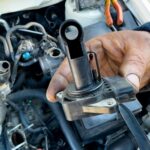Eco Obd2 Fuel Savers are devices that plug into a car’s OBD2 port, claiming to reduce fuel consumption by adjusting various engine parameters. These small devices receive information from the car’s Engine Control Unit (ECU) and supposedly optimize fuel injection, boost pressure, and timing to improve fuel efficiency. But do these devices live up to their promises? This article will explore how eco OBD2 fuel savers work and examine their potential impact on fuel economy.
How Eco OBD2 Fuel Savers Claim to Work
The core functionality of an eco OBD2 fuel saver relies on its ability to communicate with the car’s ECU. Upon plugging into the OBD2 port, the device begins collecting data on various engine parameters, including:
- Engine speed
- Throttle position
- Coolant temperature
- Air intake pressure
Based on this data, the eco OBD2 fuel saver then attempts to modify the engine’s performance by adjusting parameters such as:
- Fuel injection timing and quantity
- Boost pressure (for turbocharged engines)
- Ignition timing
These adjustments are intended to optimize the combustion process, leading to a claimed reduction in fuel consumption. Manufacturers often advertise significant fuel savings, ranging from 15% or more.
Fuel Savings and Potential Impact on Your Car
While manufacturers often tout significant fuel savings, independent testing and user reviews offer a mixed picture. Some users report minor improvements in fuel economy, while others see no noticeable difference. Factors influencing potential fuel savings can include:
- Driving habits: Aggressive driving styles may negate any potential benefits.
- Vehicle type and age: Older vehicles might experience more noticeable changes.
- Existing engine condition: A well-maintained engine might already be operating at optimal efficiency.
It’s crucial to consider the potential impact on your car’s engine. While most eco OBD2 fuel savers claim not to cause harm, modifying engine parameters could potentially lead to:
- Increased engine wear and tear
- Voided warranties (consult your vehicle’s warranty terms)
- Unexpected engine performance issues.
Installation and Compatibility
Installation is generally straightforward. The device simply plugs into the OBD2 port, usually located under the dashboard. Eco OBD2 fuel savers are often advertised as compatible with a wide range of petrol (gasoline) vehicles. However, compatibility can vary, so it’s essential to check the manufacturer’s specifications before purchasing. Diesel vehicle owners should seek specific eco OBD2 fuel savers designed for diesel engines.
Conclusion
Eco OBD2 fuel savers offer a potentially appealing solution for reducing fuel consumption. However, it’s important to approach these devices with a healthy dose of skepticism. While some users may experience minor improvements in fuel economy, substantial savings are unlikely. Furthermore, potential risks to your engine and warranty should be considered. Thorough research, including independent reviews and comparisons, is recommended before investing in an eco OBD2 fuel saver.
